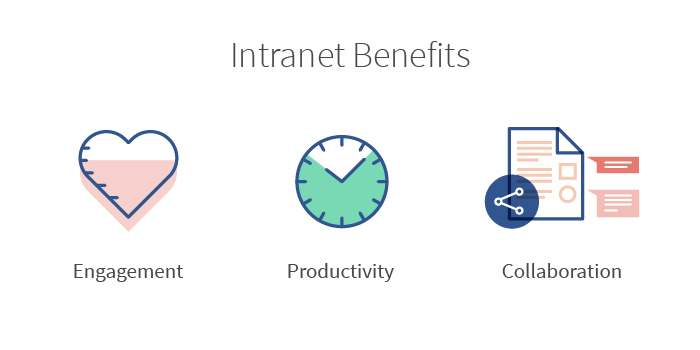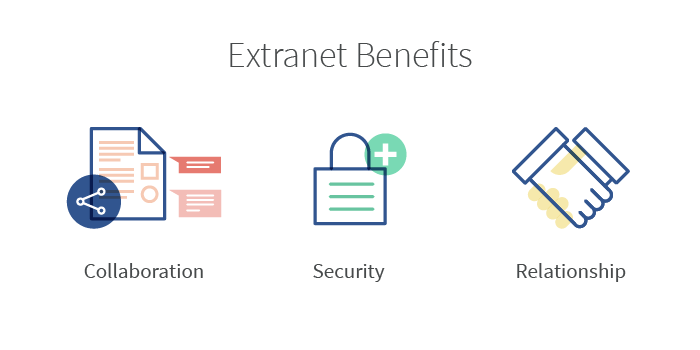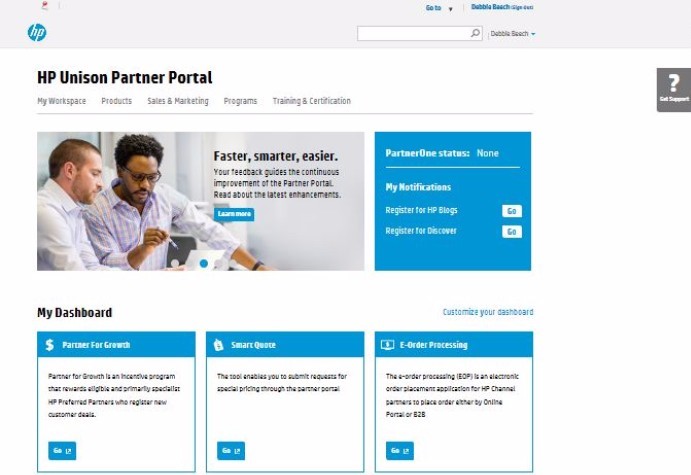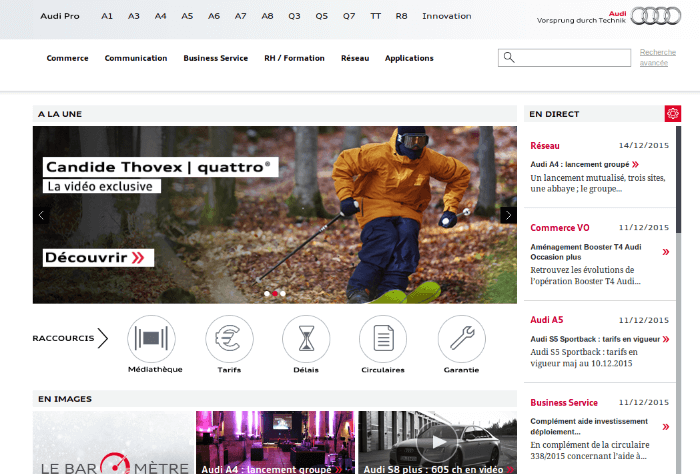Note: This article was last updated August 22, 2025.
Key Takeaways:
-
An intranet is an internal site for employees to work more productively together.
-
An extranet is a portal designed to help teams collaborate better with external parties. For example, partner portals, vendor portals, supplier portals, and dealer portals are examples of extranets.
Intranets vs. Extranets: What’s the Difference?
There’s naturally a level of confusion people have on the difference between intranets and extranets. This is understandable given there can be overlap in the way they are used.
A modern intranet is an internal site, designed for employees to work together more productively and seamlessly with other employees. Intranet functions enable employees to create content, access department information, and employees chat directly with colleagues, all within a secure environment. Intranets are valuable tools for improving communication, streamlining internal operations and processes, and supporting project management across multiple locations. They help keep staff informed and connected, no matter the industry. Extranets, on the other hand, help employees collaborate better with external parties - such as authorized customers, partners, or vendors - who are granted secure extranet access.
Think of an intranet as a private, internal network for employees using familiar internet technologies, but operating securely away from the general global internet. Similarly, an extranet is like an extension of an intranet. It remains secure, but in this case it’s a custom built platform accessible for specific, authorized external users who wish to collaborate together.
Most organizations - especially as their networks and supply chains become more complex - will benefit from both. Whether from using an intranet or an extranet, employees especially stand to gain in terms of making their working lives easier and more streamlined. Intranets enable internal users and internal stakeholders to collaborate more effectively. Equally, intranets and extranets are a potent source of data and analytics, which enables management to find opportunities to improve employee engagement and the employee experience.
Benefits of Intranets
How would you use an intranet or an extranet more specifically? Do you need either of these solutions for your own organization’s purposes? Let’s start by summarizing the benefits of both intranets and extranets, individually:

|
Intranets benefit your company by increasing engagement, collaboration, and productivity among your employees. A well-designed intranet is a tool that makes it easier for people to do their jobs and streamlines the process of jumping between different sites and applications that most people use in a typical work day. Instead, all the required information people need to do their jobs is centralized and up to date in one convenient location, ensuring that employees always have access to relevant information. Intranets can help employees find the information they need faster, onboard and get started quicker, and raise questions easily if they need. |
||
|
|
||
|
|
Read five intranet case studies that improved employee productivity, plus guidelines for designing your own. Read the E-book now.

Benefits of Extranets
|
|
||||
|
|
||||
|
|
Comparison Between Intranet Software and Extranet Tools
While intranet and extranet solutions may be targeted towards different audiences, these portals require many of the same capabilities in order to effectively unify their audiences and deliver the resources, information, and tools needed to succeed.
How Both Networks Can Work Together
While intranet and extranet solutions may be targeted towards different audiences, these portals require many of the same capabilities in order to effectively unify their audiences and deliver the resources, information, and tools needed to succeed.
Similarities Between Intranets and Extranets
-
Robust authentication and permissioning: Intranets and extranets are both private networks that require secure web-based logins. Therefore, strong authentication capabilities are required to ensure that only the right users are able to log in. For example, you don’t want a customer to accidentally be able to access internal company documents within the intranet. Look for software that offers secure and efficient authentication tools including multi-factor authentication (MFA) and single sign-on (SSO). Additionally, it’s just as critical to manage what users have access to after they log in. With granular permissioning and roles, you can define what users are able to view, edit, or manage.
-
Personalization for tailored experiences: Employees, partners, vendors, dealers, suppliers -- any audience really -- wants a personalized experience. Tailoring their portal experience helps the user see what's most relevant to them quickly, but also helps to make them feel valued and understood. So users not only feel more productive, but also more engaged and committed.
-
Powerful search functions: Because they are both based on modern web technologies, both intranets and extranets feature powerful search functionalities that significantly help today’s knowledge workers in locating the right documents and features. This is particularly important in an extranet context, assisting disparate external groups with cross-company collaboration that keeps everyone on the same page, literally.
-
External software integration: Both intranets and extranets have the capability for facilitating software integrations, although the exact application of this feature will vary project by project, and collaboration ecosystem by ecosystem. These integrations help both employees and external parties by housing familiar tools within the one space - this could be anything from Google Workspace (formerly G Suite) to Office 365, Salesforce, Slack, SharePoint Online, and more. It’s all about improving collaboration and productivity.
Differences Between Intranets and Extranets
-
Internally vs Externally Housed: While both act as a central repository for important documents and projects and also allow for collaboration among various groups, an intranet is housed internally whereas an extranet is more likely to be accessible via a secure web-based platform. The technical structure of each also tends to vary, particularly with relation to permissions and access rules which can be set by the project owner.
-
Different End Users: Both platforms feature capabilities for content and document management. The primary difference is an intranet is naturally focused on usage by employees only, whereas an extranet facilitates document processing and editing for external parties such as suppliers, agencies, partners, and so forth.
-
Privacy and Data Security: When it comes to privacy and security, there are a couple of differences between intranets and extranets. Passwords and data encryption is used in an intranet context, meeting the needs for internal groups and company data security. Additional security layers are often deployed for extranets to protect external access to confidential data and tools. This might include firewalls to isolate certain information away from the private network. Identity authentication plus access and permission management can also be used as an additional protective layer.
How Both Networks Can Work Together
Extending an Intranet Platform With Extranet Capabilities
Today, companies with large networks of partners, vendors, or other external non-customer user groups need to account for a variety of needs, and well-designed extranets allow companies to create useful, productive workspaces for each audience.
However, justifying the creation and maintenance of an extranet can be a challenge, especially for teams with limited development resources. Building your extranet as an extension of your intranet is one way to break past this obstacle. It allows you to reuse components that are valuable to all audiences, maintain consistent and connected databases between different sites, and ensure that security policies are correctly applied according to sites and users, reducing the risk of external parties having access to confidential information. In many ways, it can be helpful to view your extranet as a sub-project of your intranet, conforming to the same standards and design processes, even as each site delivers services unique to its audience’s needs.
Extranets are Built for Complexity - Controlled Access on a Private Network
Extranets are suited for managing extremely complex business processes and relationships, communication, and collaboration - beyond what an intranet can achieve on its own. For example, Hewlett Packard uses an extranet to support its ecosystem of global partners. The company has to support 650,000 users across 174 countries in 25 languages. Moving everyone onto a single, global URL was groundbreaking for managing the company’s relationships with all of its partners.

Likewise, Volkswagen Group France uses both a modern intranet and an extranet to manage more than 30,000 users across 5 brand sites. While the intranet features employee-specific services for team members, such as booking a conference room, the extranet allows all authorized dealers to receive company news and other information they need for day-to-day business. Integration with the intranet allows them to access the same repository of business documents, making content management easier for Volkswagen’s team.

Technical Requirements for Implementing Intranet and Extranet Solutions
Successfully implementing an intranet or extranet requires careful attention to technical requirements and security considerations. Organizations must ensure that their network infrastructure can handle the demands of both platforms, including robust data security measures, access controls, and sufficient bandwidth. It’s important to select intranet and extranet software that integrates smoothly with existing systems and provides a user-friendly experience for employees.
Special attention should be paid to managing external access, as this introduces additional security risks that must be mitigated to protect sensitive internal information. By proactively addressing these technical requirements and potential security risks, organizations can create a secure environment that supports improved communication, collaboration, and productivity across both internal and external user groups.
Consider as well what kind of technology could help you build the intranet and extranet tools you need, like a digital experience platform (DXP) that gives you the capabilities to build both an intranet and an extranet on the same platform.
Do You Need an Intranet or an Extranet?
If you’re deciding on whether to build or extend an intranet or an extranet - or both - the main question to answer is: Do we have the resources to make it a great experience for users?
Companies have to be intentional about maintaining and improving their intranets and extranets so that they are user-friendly and provide true value to users. This means regularly seeking out feedback and incorporating fixes and feature requests into your updates. This may be something your team can monitor, or you may want to bring in a partner manager to offer their perspective on what partners want.
Keep in mind that intranets and extranets have different goals. For example, while it’s appropriate for your intranet to have a page for the company jogging club, that kind of culture-building will be less relevant to your vendors. Stay aware of the relationships you’ve built with partners, and make sure that your extranet appropriately reflects that work culture. You’re designing a tool for them, not for your own corporate initiatives. When done well, the loyalty and satisfaction earned will prove its own ROI in the long run.
Learn more about Liferay’s modern intranet solutions, which are designed to help your business run more efficiently, better address the needs of an evolving workforce, and drive consistency in service delivery for employees across the world.
Découvrez comment créer une solution adaptée à vos besoins
29 rue Taitbout
75009 Paris
France
+33 (0)1 84 21 11 80
